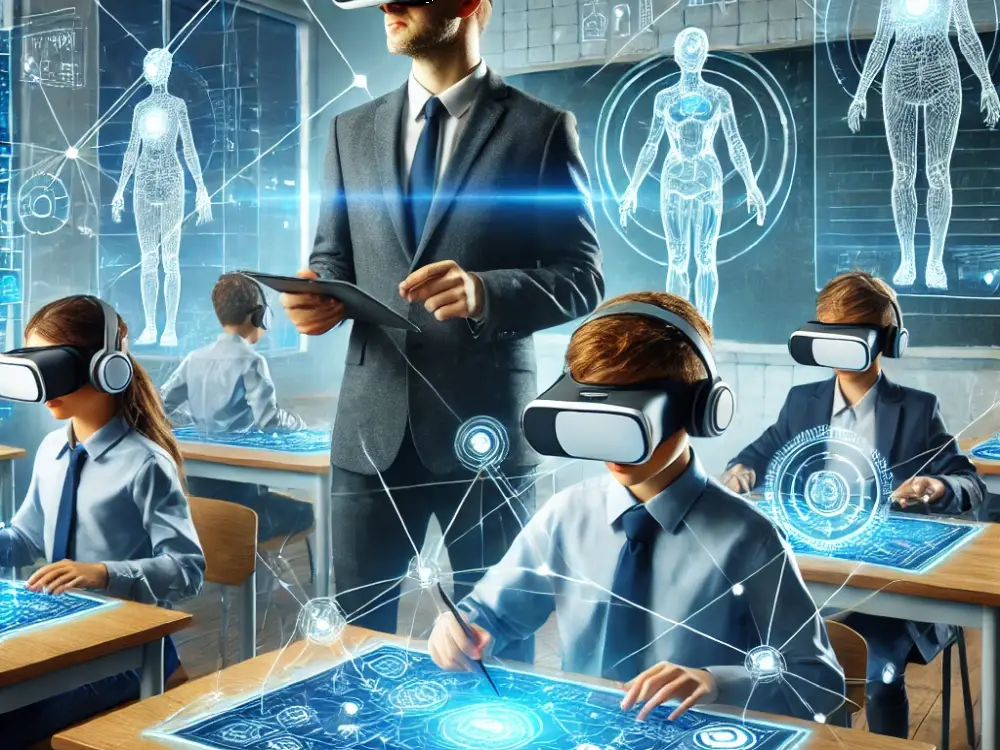Equip Your Business Operations with the most up to date AI Tools Available
Equip Your Business Operations with the most up to date AI Tools Available
Blog Article
Innovative Strategies for Enhancing Innovation Education in Today's Knowing Environments
The advancing landscape of technology education and learning requires a reevaluation of typical instructional techniques to much better outfit pupils for the intricacies of the contemporary globe. Innovative methods, such as hands-on knowing experiences and joint project-based initiatives, play an important function in linking theoretical ideas with useful applications. Furthermore, the integration of on the internet sources and gamification can enhance interaction and inspiration amongst students. As we explore these methods, it becomes essential to think about exactly how tailored learning can additionally enhance the educational experience and foster a deeper link in between students and innovation. What might this mean for the future of education and learning?
Hands-On Knowing Experiences
Hands-on knowing experiences function as a foundation in modern technology education and learning, effectively linking the void in between theoretical expertise and useful application. These experiential activities make it possible for students to involve directly with devices, software application, and technology, fostering a deeper understanding of concepts that are typically abstract in conventional classroom settings.
By integrating hands-on understanding, instructors can promote an atmosphere where pupils can experiment, innovate, and troubleshoot. This approach not only cultivates technical skills but likewise enhances problem-solving abilities, as trainees are encouraged to challenge real-world difficulties. Moreover, hands-on experiences usually bring about increased student motivation and engagement, as students see the instant importance of their research studies to functional circumstances.
Additionally, such experiences can take various types, including lab experiments, simulations, and interactive projects, every one of which satisfy various understanding styles. The assimilation of hands-on discovering in innovation education and learning additionally advertises retention of information, as trainees are most likely to bear in mind principles they have actually actively dealt with rather than passively observed. Overall, hands-on experiences are necessary in preparing pupils for the intricacies of the contemporary technological landscape, furnishing them with the skills and confidence required to prosper in their future occupations.
Joint Project-Based Knowing
Collaborative project-based discovering encourages pupils to work with each other in teams to address complex, real-world issues, fostering vital abilities for the modern workforce. This technique motivates energetic engagement, vital thinking, and creative thinking, as pupils bargain roles, share responsibilities, and collectively create solutions. By immersing themselves in projects that reflect genuine challenges, learners establish a deeper understanding of the subject issue while honing their ability to connect and collaborate effectively.
In technology education and learning, collective project-based discovering can materialize through interdisciplinary projects that integrate aspects of design, engineering, and coding. For example, students could team up to develop a mobile application or style a prototype that attends to a societal problem, requiring them to incorporate various technical principles and tools. This experiential understanding not only improves technical effectiveness yet additionally cultivates problem-solving abilities and adaptability.
Additionally, such collaborative endeavors promote a feeling of area among pupils, cultivating social partnerships and a shared commitment to their job results. As they browse the intricacies of team effort, students find out to appreciate varied point of views and take advantage of each other's toughness, preparing them for future professional settings where partnership is essential. Ultimately, collaborative project-based knowing is a cornerstone of effective innovation education.
Assimilation of Online Resources

The assimilation of on the internet sources facilitates accessibility to up-to-date info and sector standards, which is necessary in a swiftly advancing technological landscape. By leveraging platforms such as MOOCs (Huge Open Online Courses) and specialized training sites, teachers can supplement traditional educational programs with real-world applications, making it possible for pupils to engage with existing fads and practices.

Inevitably, the thoughtful integration of on the internet resources in innovation education and learning cultivates a much more vibrant, appealing, and pertinent discovering experience, furnishing trainees with the abilities and expertise necessary to prosper in a significantly electronic world.
Gamification Techniques in Education And Learning
The incorporation of gamification methods in education and learning represents an effective strategy to even more engage students and boost their discovering experiences. By integrating game-like elements such he said as points, badges, and leaderboards into the curriculum, teachers can stimulate inspiration and cultivate a sense of competition among students. These strategies encourage engagement and persistence, specifically in topics that might or else show up intimidating.
Gamification can take different types, including interactive quizzes, collaborative projects, and immersive simulations, which allow trainees to use their expertise in sensible contexts. This interactive approach not only makes discovering satisfying yet additionally strengthens crucial concepts with repeating and immediate responses. As trainees progression, they can track their achievements, promoting a growth state of mind and a sense of accomplishment.
In addition, gamification assists in separated direction by accommodating varied understanding styles and speeds. Pupils are equipped to take possession of their knowing trip, enabling an extra personalized educational experience. In an increasingly electronic world, the usage of gamification strategies can bridge the space between typical education and modern-day technological improvements, inevitably preparing students for future challenges.
Personalized Discovering Approaches
Customized learning techniques are significantly recognized as vital for attending to the varied demands and choices of students in today's instructional landscape. These methods empower students by customizing educational experiences to specific passions, toughness, and finding out paces, consequently improving engagement and retention.
In modern technology education and learning, personalized discovering can take different kinds, including flexible discovering modern technologies, customized curricula, and project-based discovering tailored to student rate of interests. Platforms that utilize synthetic knowledge can analyze a pupil's performance data to advise particular sources or tasks that line up with their understanding style.
Moreover, individualized knowing encourages student company, permitting students to establish goals and choose pathways that resonate with their desires (Education). This autonomy promotes a much deeper link to the material, eventually resulting in improved end results
Educators play an essential role in this process, using formative evaluations to keep track of development and readjust instruction as necessary. Collective tools and electronic portfolios can additionally assist in tailored understanding, permitting pupils to mirror on their journeys and showcase their success.
Verdict
Finally, improving innovation education in contemporary learning environments use this link necessitates the application of ingenious methods that prioritize hands-on discovering, collective projects, and the assimilation of online sources. Gamification methods serve to increase engagement and inspiration, while customized knowing techniques suit specific toughness and foster student agency. Jointly, these strategies create a dynamic educational experience that prepares students for real-world obstacles and cultivates vital abilities for future success in a quickly advancing technological landscape.
As we discover these methodologies, it comes to be imperative to consider just how individualized discovering can additionally improve the instructional experience and cultivate a he said much deeper connection between pupils and modern technology. The assimilation of hands-on learning in technology education also promotes retention of info, as pupils are more most likely to bear in mind concepts they have proactively functioned with rather than passively observed.The incorporation of gamification methods in education and learning represents a powerful approach to additionally involve pupils and enhance their knowing experiences. Pupils are equipped to take possession of their learning trip, allowing for an extra tailored academic experience.In conclusion, improving innovation education in contemporary learning environments necessitates the implementation of innovative techniques that prioritize hands-on knowing, collective jobs, and the combination of online sources.
Report this page